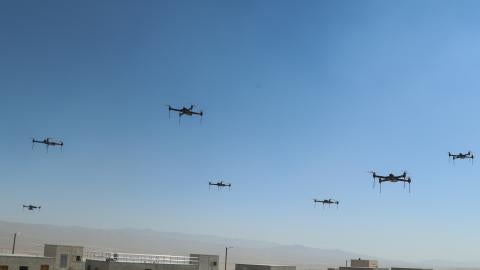The Pentagon’s announcement of its new “Replicator” initiative is a welcome, albeit belated, recognition that uncrewed vehicles are playing an outsized role in military operations. But to succeed, Replicator will need to avoid the ambitious goals and lack of integration that led previous U.S. uncrewed systems to be shrunk or scrapped.
Our new study, Unalone and Unafraid, analyzes the reasons that uncrewed systems have not become integral to the U.S. military and proposes a new approach to fielding them focused on existing technology and today’s operational problems. Deputy Defense Secretary Kathleen Hicks highlighted these characteristics in announcing Replicator, but achieving them will require a sustainable process that breaks with the Pentagon’s inclination to build everything from scratch.
There is general agreement that Replicator’s goal of building thousands of drones makes sense. Numerous studies have highlighted the U.S. military’s growing shortfalls against China and the imperative for new strategic and operational concepts. As we have argued, Secretary Hicks said the Department of Defense (DOD) needs to use operational innovation, supported by a more adaptable force, to regain an advantage against China.
Unlocking the creativity of warfighters will require rebalancing the U.S. military from a shrinking collection of expensive, self-contained aircraft, ships and armored vehicles to one that incorporates a large and growing number of simpler and less-expensive uncrewed vehicles. Like mosaic tiles, the more diverse force that would result could be mixed and matched in a greater variety of packages to support a wider range of operational concepts.
Achieving the adaptability Secretary Hicks wants will demand discipline in adopting uncrewed technology and combining it with today’s force — two areas where the DOD has a poor track record.
Build Teammates, Not Replacements
Defense technologists never met a research program they didn’t like and uncrewed systems are no exception. For example, the U.S. Navy’s Large Unmanned Surface Vessel program has languished through half a decade of congressional marks and skepticism because its goal of acting as an auxiliary missile magazine on months-long deployments was beyond what today’s technology can deliver. Moreover, at nearly $300 million per ship, an LUSV costs a third as much as the Navy’s new multimission frigate.
The Navy’s trials with LUSV echo the experience of commercial robot users. One approach to automate a facility like an Amazon warehouse is to build robots that mimic humans, unloading trucks, stocking shelves, boxing items, and loading delivery vehicles. But robots with the intelligence and flexibility to step into any worker’s role are expensive and difficult to achieve with today’s technology. Instead, many companies are buying robots off the shelf and adapting their workflows to use either robots or people where they work best.
The DOD is now defaulting to this model with some of its highest-profile uncrewed systems. The LUSV is being characterized as “semi-autonomous” and will have operators on board most of the time. After finding its goal of multi-month patrols was infeasible without extensive human support, the Navy adjusted the mission of its Orca extra-large uncrewed undersea vehicle to shorter out-and-back mine delivery. And the Army revised its Bradley Fighting Vehicle replacement from being optionally-manned to essentially be optionally unmanned.
Like its counterparts in the commercial world, the DOD should field uncrewed systems under the assumption operators will make up for limitations in autonomy, rather than incorporating humans only after a program falls short of overly-optimistic ambitions. That means the Pentagon will need to pivot from its traditional approach of developing new systems to perpetuate its current tactics and instead adapt its workflows to use the uncrewed vehicles available today.
Embrace Integration as Innovation
The need for humans and machines to work together is more than a necessity borne from technical limitations — it is a source of advantage for U.S. forces. As Secretary Hicks noted in her announcement, uncrewed systems can help unlock the creativity of operators, whose improvisations have often proven decisive in battle.
The lack of heterogeneity and quantity in today’s U.S. military constrain operational innovation. The shrinking and increasingly expensive crewed force needs to be protected and sustained in battle, limiting the variety of compositions and tactics it can pursue. Uncrewed systems could enable greater adaptability and resilience because they can be more numerous, expendable, and modular than crewed platforms.
But obtaining those qualities in uncrewed systems means using an entirely different approach to field them compared to crewed ships, aircraft, or armored vehicles. Crewed platforms are built to be used over decades for a wide and open-ended set of missions, integrating with the rest of the force primarily via their human operators. To be inexpensive and achieve scale, uncrewed vehicles can only perform a few functions and will depend more than their crewed counterparts on machine-to-machine communication with other systems for direction, situational awareness, and sustainment.
Like the commercial warehouse robots, military uncrewed vehicles should be fielded as part of a team of crewed and uncrewed systems — as is being done by U.S. Central Command’s uncrewed task forces. And rather than addressing predicted future gaps like the traditional Pentagon acquisition process, the availability of sophisticated uncrewed vehicles suggests their workflows should address the operational problems faced by combatant commanders today.
The technical challenge for the DOD, therefore, will shift from vehicle development to integrating adaptable systems of systems. The Rapid Development and Experimentation Reserve, or RDER, and related mission-integration efforts by the Undersecretary of Defense for Research and Engineering offer one path to rapidly field prototype systems that introduce uncrewed vehicles as part of a useful workflow.
Replicator presents the Pentagon with an opportunity to reframe its process for developing uncrewed vehicles from the industrial model of the 20th century to the customer-focused model of the 21st. But if the initiative fails to integrate existing uncrewed systems in ways that solve today’s operational problems, it could end up as another failed Pentagon science project.

















